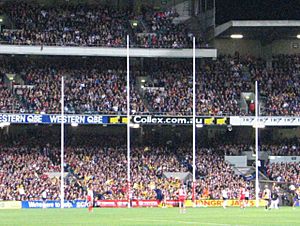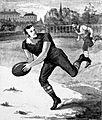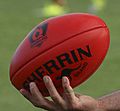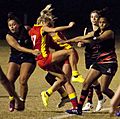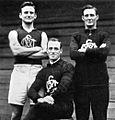Australian Rules Football facts for kids
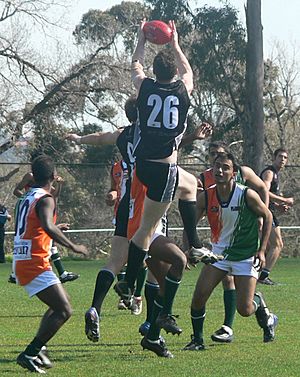
Australian rules football is an exciting sport that was created in Australia. It's the national sport there and is super popular! The main competition for Australian rules football is called the Australian Football League, or AFL.
Contents
How Australian Rules Football Started
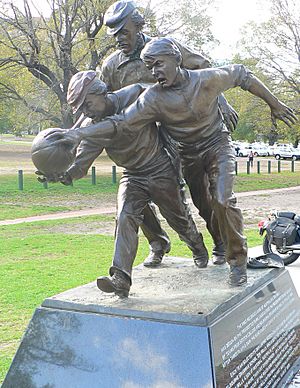
In 1858, a man named Tom Wills came up with the rules for a new kind of football. Wills had studied at famous schools like Rugby and Cambridge. He mixed ideas from rugby, soccer, and Gaelic football. He created the game to help cricket players stay fit during the winter when they weren't playing cricket. Other people, like his cousin H.C.A. Harrison, and W.J. Hammersly and J.B. Thompson, also helped him.
Tom Wills grew up with Indigenous Australians. He learned their language and played with the children. Some people believe that Australian Rules Football was partly inspired by Marn Grook. This was an Aboriginal game with some rules similar to Australian Rules Football. Since Wills played with Indigenous children, he would have known about Marn Grook. This game likely influenced him when he made the rules for his new sport.
The Melbourne Football Club started on May 14, 1859. It's one of the oldest football clubs still around today! An important game was played between Scotch College and Melbourne Grammar School. It lasted three days on a field near the Melbourne Cricket Ground. These two schools have played a game every year since then.
At first, the game was known as Melbourne Rules Football. Over time, as it became popular in other states, people started calling it "Australian Rules."
The Australian Football League (AFL) Begins
The Victorian Football League (VFL) was created in 1896. The first official games were played the next year. The first clubs were Carlton, Collingwood, Essendon, Fitzroy, Geelong, Melbourne, St Kilda, and South Melbourne.
More teams joined the league over the years:
- West Coast Eagles (joined in 1987)
- Brisbane Bears (1987)
- Adelaide Crows (1991)
- Fremantle Dockers (1995)
- Port Adelaide (1997)
- Brisbane Lions (1997, formed when the Brisbane Bears and Fitzroy Lions joined together)
- Gold Coast Suns (2011)
- Greater Western Sydney Giants (2012)
In 1990, the Victorian Football League changed its name to the Australian Football League (AFL). Some teams also changed their names. For example, Footscray became the Western Bulldogs in 1997.
Playing Australian Rules Football
Australian rules football is the most popular sport in Australia. It's common for 50,000 to 80,000 people to watch regular games! During the finals or special matches, the Melbourne Cricket Ground (MCG), which is the home of football, can have 100,000 people watching! The biggest crowd ever was 121,696 people in 1970.
Team Structure and Game Play
There are 18 teams in the AFL. Each team has 22 players on game day, but only 18 players are on the field at one time. These 18 players are usually split into 6 forwards, 3 centers, 6 backmen, and 3 followers. The other 4 players are reserves. Three of these reserves can swap with any other player as often as the coach wants. The fourth reserve can replace a player, but that replaced player cannot come back into the game.
Every game has 4 quarters. Each quarter lasts 20 minutes, plus extra time for stoppages. After each quarter, the teams switch ends of the field. A quarter starts when the umpire blows their whistle and bounces the ball in the middle of the field. This is similar to a "tip-off" in basketball. Players then try to tap or punch the ball to their teammates.
The main idea of the game is to kick more goals than the other team. At each end of the field, there are 4 tall poles. Players score points by kicking the ball between these poles. A "goal" is a kick that goes between the two center posts. This is worth 6 points. A "behind" is a kick that goes between an outer post and a center post. This is worth 1 point.
Players can bounce the ball while running. They can also hit the ball with their hand (this is called a "handball") to pass it to other players. If a player catches the ball after another player has kicked it high in the air, it's called a "mark." When a player takes a mark, they cannot be tackled until they decide to play on.
Australian Rules Football is the only "football" game where the main score (a goal) can ONLY be scored with the foot.
Current AFL Teams
Here are the teams that play in the AFL:
| Club | Nickname | City, State | Home Ground |
|---|---|---|---|
| Adelaide Football Club | Crows | Adelaide, South Australia | Adelaide Oval |
| Brisbane Lions | Lions | Brisbane, Queensland | Brisbane Cricket Ground (The Gabba) |
| Carlton Football Club | Blues | Carlton, Victoria | Etihad Stadium/ Melbourne Cricket Ground ( MCG ) |
| Collingwood Football Club | Magpies | Collingwood, Victoria | Melbourne Cricket Ground ( MCG ) |
| Essendon Football Club | Bombers | Essendon, Victoria | Etihad Stadium |
| Fremantle Football Club | Dockers | Fremantle, Western Australia | Perth Stadium |
| Geelong Football Club | Cats | Geelong, Victoria | Skilled Stadium |
| Gold Coast Football Club | Suns | Gold Coast, Queensland | Metricon Stadium |
| Greater Western Sydney Giants | Giants | Blacktown, New South Wales | Blacktown Olympic Park |
| Hawthorn Football Club | Hawks | Hawthorn, Victoria | Melbourne Cricket Ground (MCG)/ Aurora Stadium |
| North Melbourne Football Club | Kangaroos | North Melbourne, Victoria | Etihad Stadium |
| Melbourne Football Club | Demons | Melbourne, Victoria | Melbourne Cricket Ground (MCG) |
| Port Adelaide Football Club | Power | Port Adelaide, South Australia | Adelaide Oval |
| Richmond Football Club | Tigers | Richmond, Victoria | Melbourne Cricket Ground (MCG) |
| St Kilda Football Club | Saints | St Kilda, Victoria | Etihad Stadium |
| Sydney Swans | Swans | Sydney, New South Wales | Sydney Cricket Ground (SCG) |
| West Coast Eagles | Eagles | Perth, Western Australia | Perth Stadium |
| Western Bulldogs | Bulldogs | Footscray, Victoria | Etihad Stadium |
Major Awards in Australian Rules Football
Players can win many important awards in the AFL:
- Brownlow Medal (for the best and fairest player in the season)
- Coleman Medal (for the player who kicks the most goals)
- AFL Rising Star (for the best young player)
- Leigh Matthews Trophy (for the most valuable player, voted by other players)
- Norm Smith Medal (for the best player in the Grand Final game)
- Michael Tuck Medal (for the best player in the pre-season Grand Final - this award is no longer given)
- AFL Mark of the Year (for the best mark, or catch, in the season)
- AFL Goal of the Year (for the best goal kicked in the season)
- All Australian Team (a special team made up of the best players from all clubs)
- Club Best and Fairest Awards (for the best player in each individual club)
Images for kids
-
An old picture from 1866 showing a football match at the Richmond Paddock. You can see the MCG in the background!
-
George Coulthard was one of the first players to become famous all over Australia.
-
Ron Barassi is a legend in the Australian Football Hall of Fame. He was one of the first people to suggest having a national league with clubs from all over Australia.
-
The West Coast Eagles and Sydney Swans stand for the national anthem at the 2005 AFL Grand Final. The Grand Final is usually held at the MCG and is the most-attended club championship event in the world.
-
This is a Sherrin Kangaroo Brand football. Sherrin is the official ball used in the Australian Football League.
-
Here's some action from a women's match on the Gold Coast.
-
An Australian football match at Linkbelt Oval in Nauru. Australian football is the national sport there too!
-
This photo shows South Melbourne's ruck players from the 1920s: Mark Tandy, Fred Fleiter, and Roy Cazaly. Fleiter famously shouted "Up there, Cazaly!" to signal Cazaly to jump for the ball. This phrase became a popular way to encourage people, and Australian soldiers even used it as a battle cry in World War II.
See also
 In Spanish: Fútbol australiano para niños
In Spanish: Fútbol australiano para niños


